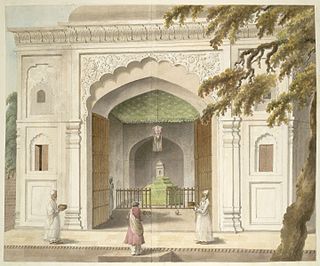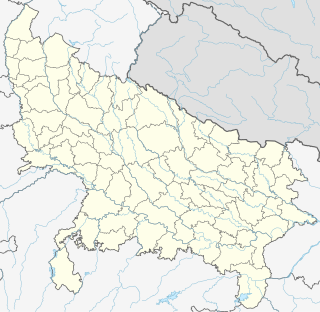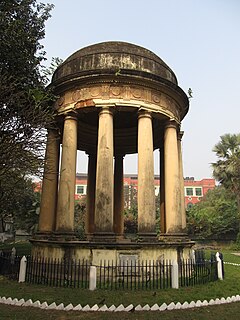
The Third Battle of Panipat took place on 14 January 1761 at Panipat, about 60 miles (97 km) north of Delhi, between a northern expeditionary force of the Maratha Empire and invading forces of the King of Afghanistan, Ahmad Shah Abdali, supported by two Indian allies—the Rohillas Najib-ud-daulah, Afghans of the Doab region and Shuja-ud-Daula-the Nawab of Awadh. Militarily, the battle pitted the artillery and cavalry of the Marathas against the heavy cavalry and mounted artillery of the Afghans and Rohillas led by Abdali and Najib-ud-Daulah, both ethnic Afghans. The battle is considered one of the largest and most eventful fought in the 18th century, and has perhaps the largest number of fatalities in a single day reported in a classic formation battle between two armies.

Rohilkhand is a region of northwestern Uttar Pradesh state of India. It is named after the Rohilla Pashtun tribes. The region was also known as Madhyadesh in the Hindu epic Mahabharata.
Rohillas are a community of Pashtun ethnicity, historically found in Rohilkhand, a region in the state of Uttar Pradesh, North India. It forms the largest Pashtun diaspora community in India, and has given its name to the Rohilkhand region. Historically, the terms Pashtun and Afghan were synonymous, but the present-day Indian constitution does not recognise Pathan as being synonymous with Afghan.

The Bareilly districtpronunciation (help·info) belongs to the state Uttar Pradesh in northern India. Its capital is Bareilly city and it is divided in six administrative division or tehsils: Aonla, Baheri, Bareilly city, Faridpur, Mirganj, and Nawabganj. The Bareilly district is a part of the Bareilly Division and occupies an area of 4120 km² with a population of 4,448,359 people according to the census of 2011.

Bijnor is a city and a municipal board in Bijnor district in the state of Uttar Pradesh, India. To boost its development, there is demand for the inclusion of Bijnor in the Delhi NCR.

Rohilla was a passenger steamer of the British India Steam Navigation Company which was built for service between the UK and India, and as a troopship. After becoming a hospital ship in the First World War, Rohilla ran aground in October 1914 near Whitby with the loss of 83 lives.

Najib ad-Dawlah, also known as Najib Khan Yousafzai, was a Rohilla Yousafzai Pashtun who earlier served as a Mughal serviceman but later deserted the cause of the Mughals and joined Ahmed Shah Abdali in 1757 in his attack on Delhi. He was also a tribal chief in the 18th century Rohilkhand, who in the 1740s founded the city of Najibabad in Bijnor district, India.

Delhi Sarai Rohilla railway station is situated about 4 km from old Delhi railway junction in India. Its station code is DEE. It is managed by Delhi Division of Northern Railway zone. Many trains from Delhi to Haryana, Punjab, Rajasthan and Gujarat stop at this station. More than twenty trains including Duronto and AC trains originate at this station.
Brigadier-General Alexander Champion was Commander-in-Chief, India.

St. John's Church, originally a cathedral, was among the first public buildings erected by the East India Company after Kolkata (Calcutta) became the effective capital of British India. It is located at the North-Western corner of Raj Bhavan, and served as the Anglican Cathedral of Calcutta till 1847, when the see was transferred to St. Paul's Cathedral. Construction of the building, modelled on St Martin-in-the-Fields of London, started in 1784, with Rs 30,000 raised through a public lottery, and was completed in 1787. It is the third oldest church in the city, next to the Armenian and the Old Mission Church.
The 12065 / 66 Ajmer Delhi Sarai Rohilla Jan Shatabdi Express is a Superfast express train of the Jan Shatabdi category belonging to Indian Railways - North Western Railway zone that runs between Ajmer Junction and Delhi Sarai Rohilla in India.
The 12982 / 81 Udaipur City Delhi Sarai Rohilla Chetak Express is a Superfast express train belonging to Indian Railways - North Western Railway zone that runs between Udaipur City and Delhi Sarai Rohilla in India.

The 22401 / 02 Delhi Sarai Rohilla Udhampur AC Express is a Superfast express train belonging to Indian Railways - Northern Railway zone that runs between Delhi Sarai Rohilla and Udhampur in India.
Falna railway station is a main railway station in Pali district, Rajasthan. Its code is FA. It serves Falna town. The station consists of 3 platforms. The platform is well sheltered. Many facilities including Water Vending Machine, Ticket Vending Machine and sanitation. Falna Station equipped with 70kW solar power supply. Falna Railway station is a part of Delhi-Mumbai Dedicated Freight Corridor. Construction had already begun & completed within few years & will be electrified too.

Ratangarh Junction railway station is a railway station in Churu district, Rajasthan. Its code is RTGH. It serves Ratangarh town. The station consists of three platforms. Passenger, Express, and Superfast trains halt here..

Sadulpur Junction railway station is a railway station in Churu district, Rajasthan. Its code is SDLP. It serves Rajgarh town. The station consists of three platforms. Passenger, Express, and Superfast trains halt here..

Kishangarh railway station is a railway station in Ajmer district, Rajasthan. Its code is KSG. It serves Kishangarh city. The station consists of two platforms. Passenger, Express, and Superfast trains halt here.

Nawab Sayyid Abdullah Khan Bahadur Rohilla was the eldest son of Nawab Ali Muhammad Khan of Rohilkhand and succeed in absentia to the throne of Rohilkhand. He was deposed by the machinations of Hafiz Rehmat Khan and replaced with his younger brother, Nawab Saadullah. Whereafter he retreated to a spiritual life of an ascetic. He eventually died fighting the British in the Rohilla War.

The Kingdom of Rohilkhand was an Indian State that arose under the declining Mughal Empire in 1721 and continued to exist until 1774. The Barha Sayyid, Ali Mohammed Khan became the first Nawab of Rohilkhand. The crown would go on being held by the Rohillas until the kingdom came to an end in 1774. Most of Rohilkhand's borders were established by Ali Mohammed Khan and largely came into an existence as a check to the power of Oudh State and in that capacity Ali Mohammed was supported by the Nizam of Hyderabad, Qamarudin Khan. It was annexed at the close of the First Rohilla War when the mismanagement of Hafiz Rehmat Khan along with the internal division of the Rohilla Confederation led to the weakening of the state.














